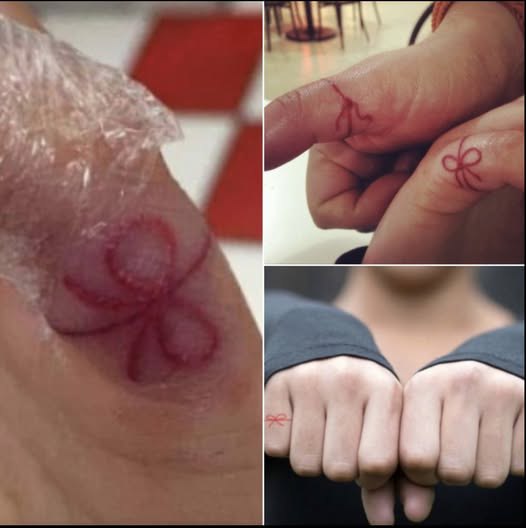Tattoos have been a form of communication long before written language existed. Across cultures and throughout history, people have marked their skin to express identity, faith, love, grief, or belonging. A symbol that seems meaningless to one person can hold an entire lifetime of emotion for the person wearing it. These visual stories often blend into the background—until a certain tattoo appears often enough to make you wonder.
One such symbol is a small red string tattooed on the hand or finger. It’s simple, minimal, almost fragile. Not bold or attention-grabbing like full sleeves or elaborate back pieces. It doesn’t shout; it whispers. A tiny bow. A thin line. A loop like a knotted string or the ends of a tied shoelace. You could see it dozens of times before realizing it isn’t random or trendy—there’s a deeper history behind it.
I used to see these tiny red string tattoos on strangers for years. The placement changed, but the meaning clearly didn’t. Most commonly, men wore it on the thumb, women on the pinky. Some chose a neat bow, others preferred a looser line that wrapped the finger like a ribbon caught mid-motion. It wasn’t loud, but it appeared often enough to make me curious.
Eventually, curiosity won. After seeing it again and again, I finally looked into its origins. That’s when I discovered that this delicate little tattoo comes from an ancient East Asian myth. It represents the “red string of fate,” a symbol rooted in destiny, connection, and love.
According to Chinese folklore—later woven into Japanese and Korean stories—a celestial matchmaker, often called the Old Man Under the Moon, ties an invisible red string around the fingers or ankles of two people destined to meet. No matter the distance, the time, or the obstacles, that invisible thread pulls them toward each other. The string may stretch or tangle, but it never breaks.
The tattoo is a visible tribute to that belief.
What makes this symbol compelling is that nearly every culture has its own version of fated connection. Soulmates, twin flames, kindred spirits, “meant to be”—people everywhere have tried to explain why certain relationships feel inevitable. The red string is simply one culture’s metaphor for that timeless idea, one that moved from ancient myth to modern skin.
For many, the tattoo is a reminder of connection. It can represent a romantic partner, but not always. Some get it for siblings, friends, or children. It symbolizes a bond they feel existed long before they met—and one they believe will outlast them.
People often assume tattoos are just about aesthetics or rebellion, but the ones that endure—the ones people treasure—almost always carry meaning. This tiny red line is no different. It’s subtle, but rich in symbolism.
Placement adds another layer. The pinky finger is traditionally tied to promises—pinky swears, vows, commitments sealed with the simplest gesture. A red string there becomes the ultimate quiet promise: a mark of someone you’re bound to. The thumb symbolizes willpower, steadiness, direction. When worn on the thumb, the string becomes a reminder of grounding and loyalty to the people who matter most.
The imagery is beautiful when you think about it: two people walking through the world connected by an invisible thread, slowly being pulled toward a moment—a touch, a conversation, a relationship, a life-changing bond. The tattoo doesn’t demand a belief in destiny; it can simply acknowledge the surprising coincidences or small decisions that bring certain people into your life.
Some find comfort in the idea. Others don’t like the thought of fate guiding anything. But belief isn’t necessary. The tattoo expresses hope, connection, and meaning. It’s a quiet declaration that relationships—romantic or not—carry power and purpose.
There’s something magical about noticing a stranger who wears a red string tattoo. You don’t know their story, but you know they have one. Maybe their string is tied to a partner they haven’t met yet. Maybe to someone they lost. Maybe to a parent, a child, or a love they believe was destined.
Tattoos like this remind us that everyone around us carries private myths. The woman in front of you at the grocery store might be honoring a mother she misses every day. The man next to you on the bus might have gotten his after finding the partner he once thought fate forgot to give him. A teenager might wear it as a sign of hope—a belief that something good is waiting for them out there.
It’s beautiful how myths evolve. Stories once whispered in ancient villages now appear in tattoo studios worldwide. A symbol once tied to lantern-lit folklore now lives on fingers across distant cities. Like threads weaving through fabric, the symbol connects people who may never meet.
Whether someone sees it as literal destiny or simply a poetic reminder of human connection, the red string tattoo carries a universal message: people matter. Bonds matter. Certain relationships shape us, anchor us, and sometimes save us.
So the next time you see someone with a red string wrapped around their hand, you might never know who their string leads to. But you can be sure of one thing: the tattoo isn’t random. It’s tied to a story, a memory, a person, or a piece of hope they refuse to let go of.
And in a world that rushes forward and forgets easily, the red string remains a quiet reminder that some connections endure—no matter the distance, no matter the time, no matter the winding path that leads two people to each other.
